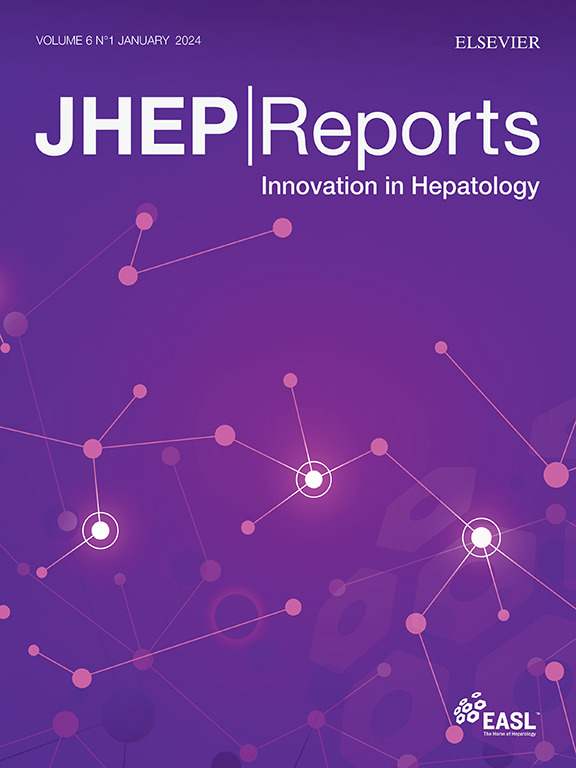p53 and TIGAR promote redox control to protect against metabolic dysfunction-associated steatohepatitis
IF 9.5
1区 医学
Q1 GASTROENTEROLOGY & HEPATOLOGY
引用次数: 0
Abstract
Background & Aims
TP53 is a potent tumour suppressor that coordinates diverse stress response programmes, ranging from pro-survival activities to cell death. p53 is also engaged during tissue damage and repair, including within the liver. Metabolic dysfunction-associated steatohepatitis (MASH) is a major driver of hepatocellular carcinoma, but our understanding of the molecular determinants of MASH remains incomplete. Here, we investigate p53 activity throughout MASH development, with implications for disease prevention.
Methods
This study utilises non-invasive imaging of p53 activity and liver-specific p53 deletion within the context of mouse models of diet and genetically induced MASH. Histopathological analyses are employed to monitor differential disease progression. Molecular mechanisms are assessed within an in vitro obesogenic system utilising western blotting and flow cytometry. Human relevance is examined through transcriptomic analyses of patients with MASH.
Results
Using a p53 reporter mouse, we report early and sustained activation of hepatic p53 in response to a high-fat and high-sugar diet (p <0.05 at 100 days in males, p <0.001 at 200 days in females). Liver-specific loss of p53 accelerates progression of benign fatty liver disease to MASH, which is characterised by high levels of reactive oxygen species, extensive fibrosis, and chronic inflammation (all p <0.0001, n = 13 per high-fat high-sugar group). Our findings indicate that p53 induces the antioxidant gene TP53-induced glycolysis and apoptosis regulator (TIGAR) in vivo and in vitro. We show that loss of TIGAR exacerbates lipid peroxidation during MASH development in vivo (p <0.001) and that TIGAR is engaged in human MASH (p <0.001).
Conclusions
Our work demonstrates an important role for the p53-TIGAR axis in protecting against MASH and implicates redox control as a barrier against disease progression that is therapeutically targetable.
Impact and implications
p53 is of intense interest as a potent tumour suppressor and compounds targeting the pathway have been developed and trialled as anti-cancer therapies. Our findings suggest that early activation of p53 is similarly protective against metabolic dysfunction-associated steatohepatitis and that redox control is an important mediator of this protection. Further studies evaluating the efficacy of proactive activation of p53 in the liver to prevent metabolic dysfunction-associated steatohepatitis, or administration of targeted antioxidants to augment p53 redox protection, could provide new treatment approaches for a condition with few approved therapies.
p53和TIGAR促进氧化还原控制以防止代谢功能障碍相关的脂肪性肝炎
背景,AimsTP53是一种有效的肿瘤抑制因子,可协调多种应激反应程序,从促生存活动到细胞死亡。P53也参与组织损伤和修复,包括肝脏。代谢功能障碍相关脂肪性肝炎(MASH)是肝细胞癌的主要驱动因素,但我们对MASH的分子决定因素的理解仍然不完整。在这里,我们研究了p53在MASH发展过程中的活性,以及对疾病预防的影响。方法本研究在小鼠饮食和基因诱导MASH模型的背景下,利用无创成像技术检测p53活性和肝脏特异性p53缺失。组织病理学分析用于监测不同的疾病进展。利用western blotting和流式细胞术在体外致肥系统中评估分子机制。人类相关性是通过对MASH患者的转录组学分析来检验的。使用p53报告小鼠,我们报告了肝脏p53对高脂肪和高糖饮食的早期和持续激活(雄性100天p <;0.05,雌性200天p <;0.001)。肝脏特异性p53的缺失加速了良性脂肪肝疾病向MASH的进展,其特征是高水平的活性氧、广泛的纤维化和慢性炎症(所有p <;0.0001,高脂肪高糖组n = 13)。我们的研究结果表明,p53在体内和体外诱导抗氧化基因tp53诱导的糖酵解和凋亡调节因子(TIGAR)。我们发现TIGAR的缺失加剧了体内MASH发展过程中的脂质过氧化(p <0.001),并且TIGAR参与了人类MASH (p <0.001)。sour的工作表明p53-TIGAR轴在预防MASH中起重要作用,并暗示氧化还原控制是一种可治疗靶向的疾病进展障碍。作为一种有效的肿瘤抑制因子,sp53引起了人们的强烈兴趣,针对该通路的化合物已被开发并作为抗癌疗法进行了试验。我们的研究结果表明,p53的早期激活对代谢功能障碍相关的脂肪性肝炎具有类似的保护作用,氧化还原控制是这种保护的重要中介。进一步的研究评估了肝脏中p53的主动激活对预防代谢功能障碍相关脂肪性肝炎的功效,或靶向抗氧化剂的管理来增强p53的氧化还原保护,可以为很少批准的治疗方法提供新的治疗方法。
本文章由计算机程序翻译,如有差异,请以英文原文为准。
求助全文
约1分钟内获得全文
求助全文
来源期刊

JHEP Reports
GASTROENTEROLOGY & HEPATOLOGY-
CiteScore
12.40
自引率
2.40%
发文量
161
审稿时长
36 days
期刊介绍:
JHEP Reports is an open access journal that is affiliated with the European Association for the Study of the Liver (EASL). It serves as a companion journal to the highly respected Journal of Hepatology.
The primary objective of JHEP Reports is to publish original papers and reviews that contribute to the advancement of knowledge in the field of liver diseases. The journal covers a wide range of topics, including basic, translational, and clinical research. It also focuses on global issues in hepatology, with particular emphasis on areas such as clinical trials, novel diagnostics, precision medicine and therapeutics, cancer research, cellular and molecular studies, artificial intelligence, microbiome research, epidemiology, and cutting-edge technologies.
In summary, JHEP Reports is dedicated to promoting scientific discoveries and innovations in liver diseases through the publication of high-quality research papers and reviews covering various aspects of hepatology.
 求助内容:
求助内容: 应助结果提醒方式:
应助结果提醒方式:


